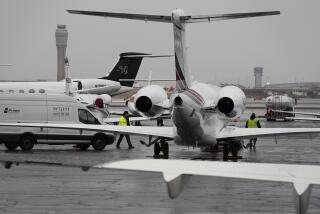Budget Concentrates on Modernizing Military
- Share via
WASHINGTON — In a budget proposal reflecting its view that new technologies are critical to future military strength, the Bush administration is set to ask Congress on Monday to boost Pentagon spending on unmanned aerial vehicles, more nimble combat ships and other new combat systems, according to documents released Friday.
The high-tech equipment will improve reconnaissance and make war fighters more lethal in the post- 9/11 world, officials say.
At a time when President Bush is calling for a near-freeze on virtually all discretionary spending, the $401.7-billion defense budget proposal continues on the growth path that would carry it to Cold War levels over the next five years.
And, in keeping with the emphasis on modernization, the budget proposes to spend $68.9 billion on research and development -- in constant dollars, the highest level of research and development spending ever.
Also in the high-tech area, the budget calls for a 13% increase in funding for the controversial missile defense program. It would rise to $10.2 billion next year, up from the $9 billion requested for fiscal 2004. The new figure includes $9.1 billion in spending by the Pentagon’s Missile Defense Agency, up from $7.6 billion, as well as funds for the Army’s Patriot missile program.
The budget request does not include money for ongoing operations in Iraq and Afghanistan. Defense officials say they are still not certain how much they will need to fund those operations. The Pentagon got an $87-billion supplemental appropriation for Iraq and Afghanistan last fall and is expected to ask for at least $50 billion in supplemental spending early next year.
The 2005 budget request is in line with the administration’s plan to increase military spending to $487.7 billion by 2009, a funding level that rivals Cold War peaks.
Pentagon officials say the increases are needed to modernize the Army and give the armed forces a broad variety of new ships, planes and weapons intended to surpass the capabilities of any future enemies.
The defense total is 7% percent higher than last year’s $375-billion Pentagon budget, and includes 1.6% growth over fiscal 2004 in the science and technology research that Defense Secretary Donald H. Rumsfeld favors.
Details of the Pentagon budget, normally not made public until the president sends his request to Capitol Hill, were inadvertently posted briefly on the Internet and then withdrawn, defense officials said Friday.
The $68.9 billion to be requested for research and development of new weapons systems is up from the $64.7 billion sought last year.
The budget proposal also will contain $74.9 billion to buy weapons and other military equipment.
That includes $1.2 billion to develop and buy new unmanned aerial vehicles, and another $710 million to develop and buy joint unmanned combat air systems to smooth the use of the UAVs among the military services.
As part of a Pentagon push to modernize the Army, the budget calls for spending $3.2 billion to develop the Army’s Future Combat System program, which includes high-tech vehicles and software designed to make soldiers more agile and to give them more real-time information about what is happening on a battlefield. That is up from $1.7 billion this year.
The defense plan funds the building of the Navy’s first DD(X) surface combatant ship and also its first Littoral Combat Ship; both vessels the Navy has said will improve its ability to fight terrorist adversaries by allowing forces to move closer to shore and deploy quickly and quietly.
The budget calls for almost $4.6 billion for Lockheed Martin Corp.’s Joint Strike Fighter, or F-35, up from $4.25 billion requested in 2004, and funds for full-rate production of 24 of the Air Force’s F/A-22 fighter planes. The aircraft is currently in low-rate initial production.
The Air Force would get three V-22 Osprey tilt-rotor aircraft in 2005 at a cost of $305.6 million, up from the $213.7 million for two Ospreys requested in the current fiscal year, according to the documents. The Osprey suffered two high-profile crashes in 2000, killing 23 Marines.
The budget proposal includes a $2.2 million boost in money to buy spare parts for Army vehicles such as tanks, armored personnel carriers and Humvees. Soldiers have complained that using the vehicles so heavily in the harsh desert environment of Iraq has caused them to break down more frequently.
There is also a slight increase for ammunition.
More to Read
Sign up for Essential California
The most important California stories and recommendations in your inbox every morning.
You may occasionally receive promotional content from the Los Angeles Times.










